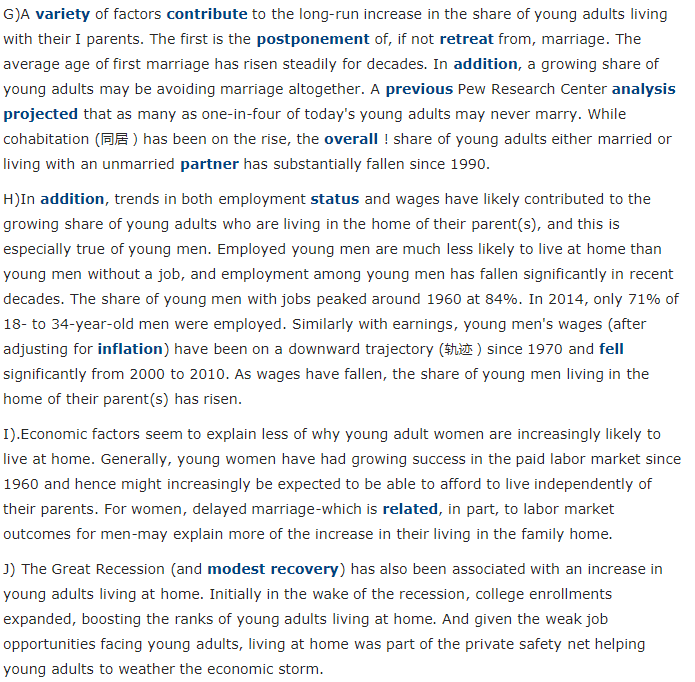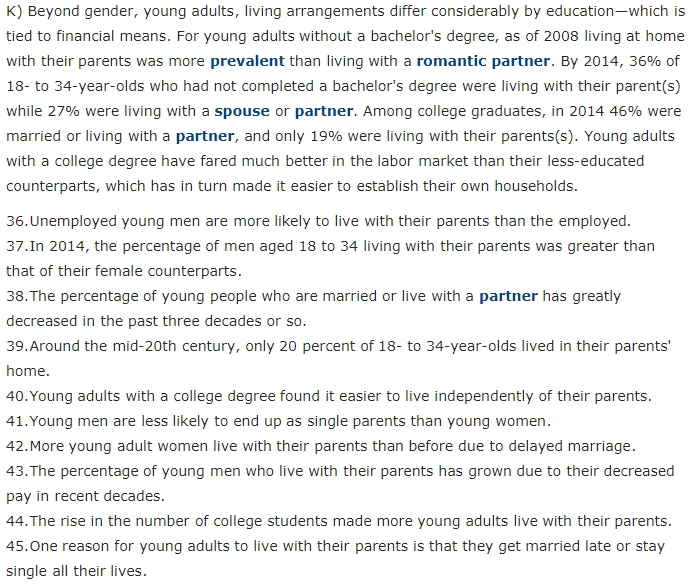-
A)Broaddemographic(人口的)shiftsi
- 时间:2023-09-06 来源:小编 人气:
A)Broad demographic (人口的)shifts in marital status, educational attainment and employment have transformed the way young adults in the U. S. are living, and a new Pew Research Center analysis highlights the implications of these changes for the most basic element of their lives -- where they call home. In 2014, for the first time in more than 130 years, adults ages 18 to 34 were slightly more likely to be living in their parents' home than they were to be living with a spouse or partner in their own household.
B)This turn of events is fueled primarily by the dramatic drop in the share of young Americans who are choosing to settle down romantically before age 35. Dating back to 1880, the most common living arrangement among young adults has been living with a romantic partner, whether a spouse or a significant other. This type of arrangement peaked around I960, when 62% of the nation's 18- to 34-year-olds were living with a spouse or partner in their own household, and only one-in-five were living with their parents.
C)By 2014, 31.6% of young adults were living with a spouse or partner in their own household, below the share living in the home of their parent(s) (32.1%). Some 14% of young adults lived alone, were a single parent or lived with one or more roommates. The remaining 22% lived in the home of another family member (such as a grandparent, in-law or sibling), a non-relative, or in group quarters like college dormitories.
D)It's worth noting that the overall share of young adults living with their parents was not at a record high in 2014. This arrangement peaked around 1940, when about 35% of the nation's 18- to 34-year- olds lived with mom and/or dad (compared with 32% in 2014). What has changed, instead, is the relative share adopting different ways of living in early adulthood, with the decline of romantic coupling pushing living at home to the top of a much less uniform list of living arrangements.
E)Among young adults, living arrangements differ significantly by gender. For men aged 18 to 34, living at home with mom and/or dad has been the dominant living arrangement since 2009. In 2014, 28% of young men were living with a spouse or partner in their own home, while 35% were living in the home of their parent (s). Young women, however, are still more likely to be living with a spouse or romantic partner (35%) than they are to be living with their parent(s) (29%).
F)In 2014, more young women (16%) than young men (13%) were heading up a household without a spouse or partner. This is mainly because women are more likely than men to be single parents living with their children. For their part, young men (25%) are more likely than young women (19%) to be living in the home of another family member, a non-relative or in some type of group quarters.


- 答案:
36-45:HEGBK FIHGJ
本题解析:36.失业的年轻人比有工作的人更可能和父母住在一起。
37.2014年,与父母同住的18至34岁男性比例高于女性。
38.在过去三十年左右的时间里,已婚或与伴侣同居的年轻人的比例大大下降。
39.大约在20世纪中叶,只有20%的18到34岁的人住在父母家里。
40.拥有大学学位的年轻人发现独立于父母生活更容易。
41.与年轻女性相比,年轻男性不太可能成为单身父母。
42.由于晚婚,与父母同住的年轻女性比以前多了。
43.由于近几十年来工资的下降,与父母同住的年轻男子比例有所上升。
44.大学生人数的增加使更多的年轻人与父母住在一起。
45.年轻人和父母住在一起的一个原因是他们结婚晚了或者一辈子都是单身。